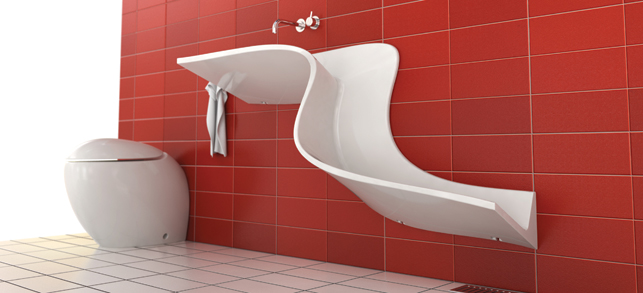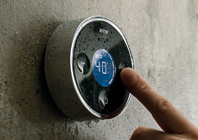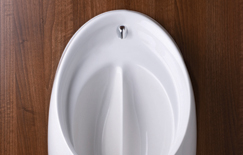A river runs through it
Bathrooms are usually an example of form follows function – a place that quickly transports you from bed to work with the least drama.

The Abisko washbasin features a sculptural, flowing design
Yet, should you want to make the room more special, and almost sculptural, without losing the functionality, you’d struggle to find a more eyecatching design than the Abisko washbasin.
The concept was to catch the sense of a mountain creek and a piece of nature; designing an element that brings the flow of mountain water of Sweden into the bathroom.
It is the result of a collaboration between Eumar Santhenica, Swedish designer Johan Kauppi and architect Lars Sundström, representing design firm We Think, from Gothenburg, Sweden.
“One of the first thoughts was to not let the used or pouring water into plastic pipes, we really didn’t want any extra details at all,” comments Kauppi.
“No pipes, no chrome, no places for soaps, no overflow holes…etc. We just wanted to give the water some freedom and an experience of finding new ways of using the water: why not wash your tired feet in the lower part?”
Collaborative sketching was moved into 3D with speed, using Rhino 3D to accurately build the model, before 3D SLA printing was used to prove the form.
“Rapid prototyping was really necessary for making the process realistic regarding time, costs and design,” explains Kauppi.
“With rapid prototyping we were able to try our design in a fast way. We could really skip the pretty inexact and time consuming process of clay modelling and paper folding, which always seems to take too much time.
“We also really love the preciseness and sharpness of having an exact result of your 3D work and form study.”
Getting the water to flow where the designers wanted was a challenge, and the unique shape was a first for manufacturers Eumar, but all roles finally merged together.
The final product was unveiled in the Swedish design hotel Kiruna Showroom, and is now available to add a mountain stream to your own bathroom at home.
www.wethink.se
No solids modelling
Unbeknown to many, conventional urinals routinely splash the user, the walls, the floor and other users with urine.
This is due to a simple design flaw: fluid hitting a flat, perpendicular surface will always reflect back as splash.
Many solutions to this problem have been proposed, however these generally aim to cure the symptoms by catching the splash rather than eliminating the cause.
London-based product designers Goodwin Hartshorn approached sanitary-ware company Ideal Standard with a new design. A central vertical ‘fin’ structure would ensure the fluid strikes the china tangentially rather than at 90 degrees to the surface. By doing this, surface tension causes the urine to cling to the surface rather than splashing off. Moreover, at such a shallow angle, any slight splashing is reflected away from the user, not back at them.
Goodwin Hartshorn updated the aesthetics and refined the form of the existing conventional urinals (the designs of which had remained unchanged for around 40 years) in collaboration with Ideal Standard’s skilled in-house technicians.
The initial concept work had already been done with the design team producing full models in SolidWorks, before doing some of their own testing to find the best angle for the central fin.
Once working with Ideal Standard the testing was increased and full-scale models developed and tested. Models were made both by hand (in blue-foam that was coated and sprayed to have a finish to match vitreous china) and using CNC-milled model-board.
The final results showed a reduction of splash by well over 90 per cent, which were independently verified by Hull University. The product is now rolling out across the UK, giving you the chance to make your own opinions.
www.goodwin-hartshorn.co.uk | www.ideal-standard.co.uk
Remote showers
Freezing cold. Scalding hot. Back to freezing. Just right. Know the feeling? Some showers are temperamental to say the least.
Design agency Priestmangoode took up the challenge to develop the perfect shower controller from shower producer Mira.
“We wanted to create a shower controller that was easy and intuitive to use,” says Priestmangoode co-founding director Paul Priestman. “The controller, which has a circular design that emulates the motion of turning on a tap, can be pre-set to a desired temperature.
“Once the water has reached the correct temperature, it stops. This allows the user to know when the water is ready: no need for cold wet arms, no water wastage and reduced energy consumption. The controller can also record different pre-set temperatures for each member of the household.”
Starting from sketches that first captured the circular form, the controller was modelled in 3D using Alias, before foam block models were built for ergonomic tests. Graphic user interface studies were used to ensure that the display was easy to operate before the product was finally modelled in Pro/Engineer.
Priestman lists “simplicity and intuitiveness” as key to the product design.
“We wanted to avoid anything complicated, like sub-menus. The design is circular because it’s the most intuitive way to use a tap: turn it to the right for hot water, to the left for cold.
“You can position the controller anywhere; it doesn’t have to be in the shower. It could be in the bedroom for instance. You could wake up in the morning, set it and the shower we heat up to your desired temperature. Once it’s reached the right temperature, it would pause until you restart it.”
With our current difficulty getting out of bed on cold mornings, this sounds like a brilliant idea!
www.priestmangoode.com | www.mirashowers.co.uk
Designs on the way you wash
Default








